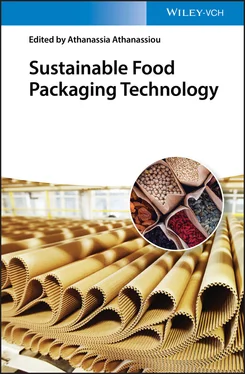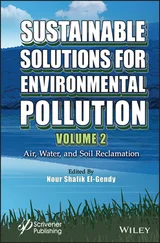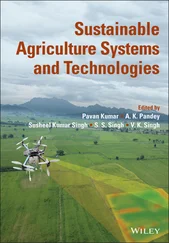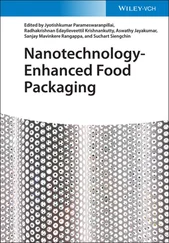Table 2.1 Fish gelatin‐based active films and coatings.
| Fish gelatin |
Packaging |
Bioactives |
Bioactivity |
References |
| Silver carp skin |
C |
Curcumin/β‐cyclodextrin |
AO + AM |
[87] |
| Tilapia fish skin |
F |
Mango peel extracts |
AO |
[88] |
| Rousselot 200FG |
F |
Tyrosol, ferulic and caffeic acids + chitosan |
AO |
[89] |
| Hagfish skin |
F |
Cinnamon‐bark essential oil |
AO + AM |
[90] |
| Tilapia skin |
F |
Epigallocatechin gallate |
AO |
[91] |
| Silver carp skin |
F |
Curcumin/β‐cyclodextrin |
AO |
[92] |
| Commercial tilapia ( Oreochromis niloticus ) |
C |
Tea polyphenol |
AO + AM |
[93] |
| Sturgeon skin |
F |
Esculine |
AO |
[94] |
| Atlantic salmon ( Salmo salar ) skin |
F |
Boldine |
AO + AM |
[95] |
| Rousselot 200FG |
F |
Coumarin + chitosan |
AO |
[96] |
| Commercial tilapia |
C |
Chitosan |
AM |
[97] |
C, coating; F, film; AO, antioxidant; AM, antimicrobial.
Some antioxidant additives show limitations, such as the poor solubility of curcumin, the major bioactive compound of curcuma rhizome ( Curcuma zedoaria ), which has been regarded as a spice, food preservative, and flavoring and coloring agent, approved for use in food industry. Wu et al. [92] and Sun et al. [87] encapsulated curcumin in β‐cyclodextrin to overcome this problem, and combined the complex with silver carp skin to prepare active films and coatings, respectively. Furthermore, it was observed that curcumin could inhibit microbial propagation. This combination of antioxidant and antimicrobial activities can be observed in several additives used with fish gelatin, for instance, in cinnamon‐bark essential oil [90] and in tea polyphenol [93]. On the other hand, some fish gelatin species have inherent antimicrobial or antioxidant activity, as in the case of Atlantic salmon [95] or cuttlefish [99], respectively.
Besides incorporation of cross‐linkers and antimicrobial and antioxidant agents into fish gelatin films and coatings, blending with other polymers such as polysaccharides could be another approach to extend food shelf life. For instance, fish gelatin and chitosan, a polymer that has intrinsic antimicrobial properties, have been shown to be compatible. When chitosan is positively charged and gelatin is negatively charged, under proper pH conditions, both biopolymers can be associated through electrostatic and hydrogen bonding. Thus, tilapia fish gelatin–‐chitosan coatings were analyzed and it was found that these coatings significantly prevented deterioration of golden pomfret fillet at 4 °C, inhibiting the degradation of myosin light chain and myoglobin [97], as well as coumarin [96]. Furthermore, the addition of natural antioxidants (ferulic acid, caffeic acid) showed that films containing caffeic acid or a caffeic–ferulic acid mixture exhibited a high radical scavenging activity [89].
2.3 Chitosan Films and Coatings
2.3.1 Chitin and Chitosan Extraction
Marine wastes, such as crustaceans' shells and squid pens, can be employed for chitin and chitosan extraction [100]. For this purpose, chemical and/or biological treatments have been employed [101]. Generally, chitin is extracted by a two‐step process, including deproteinization and demineralization [102]. In the case of shell wastes, another step, depigmentation treatment, is required in order to remove color [101]. After extracting chitin, chitosan is obtained by a deacetylation process. Depending on the aggressiveness of the treatment, the deacetylation degree of chitosan may differ, affecting the final properties of the material [103].
In terms of chemical treatments, the deproteinization step is carried out using an alkali solution (usually NaOH), the demineralization process is performed with an acidic solution (typically HCl), and the depigmentation process is accomplished by soaking the chitin in an alkali solution. Subsequently, an alkali solution (commonly NaOH) is used for the chitosan extraction [104, 105]. In the case of biological treatments, instead of chemical substances, bacteria strains are employed for deproteinization and demineralization. For instance, Bacillus subtilis , Pseudomonas aeruginosa , and Serratia marcescens , bacterial strains that produce protease, have been tested for the deproteinization treatment and Lactobacillus plantarum has been analyzed for the demineralization process to remove calcium from chitin [106]. Moreover, for the chitin transformation into chitosan, Rhizopus japonicus , a bacteria strain that processes a high intracellular and extracellular deacetylation mechanism, has been used as a biological alternative [107]. It is worth mentioning that no depigmentation process using bacterial strains has been found.
Although chemical treatments are cheap procedures, appropriate for mass production [108], high concentrations and volumes of acid and alkali solutions are used at high temperatures during chemical treatments and, thus, biological treatments could be more suitable processes from the environmental perspective. Nevertheless, they have longer production times, are more expensive, and have not been implemented for mass production; only pilot scale processes have been reported [107].
A combination of both chemical and biological methods can also be employed. For instance, Pachapur et al. [109] proposed a combined enzymatic deproteinization (with Bacillus licheniformis ) followed by a chemical demineralization process, using seawater during all steps of chitin extraction. Thereby, using large amounts of freshwater and chemicals can be avoided. Furthermore, Lopes et al. [110] compared the chitosan extraction by chemical and biological processes at pilot scale and their environmental impact. The use of a soft alkaline treatment, and the possibility of recovery NaOH, water, and fish protein hydrolysates are some of the reported improvements to decrease the environmental impact associated with the chemical treatments. Additionally, some improvements were proposed for the biological processes in order to mitigate the environmental impacts and the costs associated with the enzyme production; in particular, employing crustacean biomass as peptones for bacterial growth could be a strategy to reduce environmental loads.
Recently, a novel method for chitosan extraction has been proposed [111], using microwave technique for all chitosan extraction steps (demineralization, deproteinization and deacetylation). Although the method uses the same preparation conditions as chemical treatments, it needs less time than the conventional one. Indeed, this novel method reduced the deacetylation time from more than 6 hours to less than 30 minutes, reaching the same deacetylation degree. Furthermore, chitosan structure, morphology, and chemical composition in both methods were similar.
2.3.2 Preparation and Characterization of Chitosan Films and Coatings
Chitosan‐based materials can be prepared employing two different processes known as wet or dry techniques. The wet method is the most most employed process when using this polysaccharide because it is a versatile technique [112]. During this process, chitosan is dissolved in acidified water since it is insoluble in basic media [113, 114]. After heating and stirring the solutions, films can be obtained by solution casting and drying, or food coatings can be prepared by spraying or dipping [115, 116]. On the other hand, few works related to dry process to prepare chitosan films have been reported in the literature. Galvis‐Sánchez et al. [117] prepared chitosan films by thermal compression. First, chitosan powder was mixed with natural deep eutectic solvents, such as citric acid or lactic acid. The mixture was introduced in an oven at 80 °C for 30 minutes and then an acetic acid solution was added during manual mixing. The resultant mixture was introduced in a hydraulic press and thermo‐compressed. In another work, Guerrero et al. [118] thermo‐compressed citric acid–chitosan films at 125 °C for two minutes, using glycerol as plasticizer. Chitosan has also been compressed after blending with other polysaccharides such as starch. Valencia‐Sullca et al. [119] dispersed chitosan, starch, glycerol, and polyethylene glycol in water and the mixture was melt blended at 160 °C for 30 minutes until a homogeneous paste was obtained before processing by thermal compression.
Читать дальше











